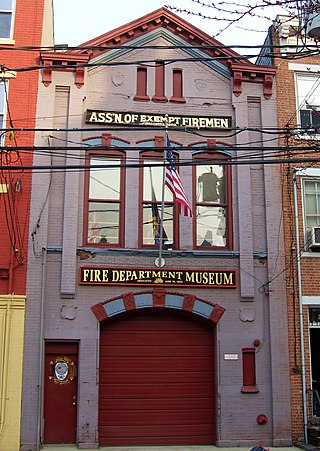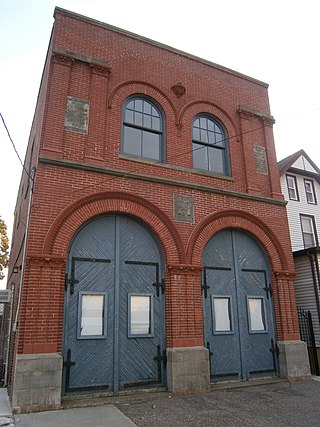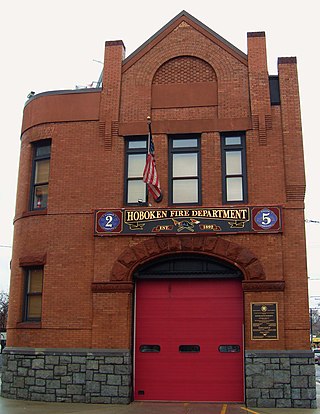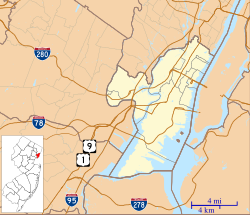
Waldwick is a commuter rail station operated by New Jersey Transit in the borough of Waldwick, Bergen County, New Jersey, United States.

Rutherford is a New Jersey Transit railroad station served by the Bergen County Line located in Rutherford, New Jersey, United States. The station is located near a traffic circle at the junction of Park Avenue, Union Avenue, Erie Avenue and Orient Way known as Station Square, with a grade crossing on Park Avenue.

The Great Atlantic and Pacific Tea Company Warehouse is a historic formerly commercial building at 150 Bay Street in Jersey City, Hudson County, New Jersey, United States. Built as a warehouse for The Great Atlantic & Pacific Tea Company (A&P) in 1900, it is the major surviving remnant of a five-building complex of the nation's first major grocery store chain. It was designated a National Historic Landmark in 1978, and now houses a mix of residences and storage facilities.

The Hudson County Courthouse or Justice William J. Brennan Jr. Courthouse is located in Jersey City, Hudson County, New Jersey, United States. The six-story structure was originally built between 1906 and 1910 at a cost of $3,328,016.56. It is considered to be an outstanding example of the Beaux-Arts architectural style in the United States.

The Old Bergen Church is a historic church congregation in Jersey City, Hudson County, New Jersey, United States. Established in 1660 in what was then the Dutch colony of New Netherland, it is the oldest continuous religious congregation in what is today the State of New Jersey. The congregation is jointly affiliated with the Reformed Church in America and the Presbyterian Church (USA). The church was added to the National Register of Historic Places on August 14, 1973. The original church building was constructed in 1680 and the current edifice was built in 1841.

The Fairmount Apartments, also known as the Grand Lady of Jersey City, are located in Jersey City, Hudson County, New Jersey, United States. The Apartments were added to the National Register of Historic Places on March 3, 1995. The Apartments are an example of an early twentieth century Arts and Crafts style apartments. The building consists of two L-shaped 4+1⁄2-story brick-and-concrete structures connected by a 1-story structure.

The Beacon is a mixed-use development located on a 14-acre (57,000 m2) site on Bergen Hill, a crest of the Hudson Palisades and one of the highest geographical points in Jersey City, Hudson County, in the U.S. state of New Jersey. The Beacon, which occupies the Jersey City Medical Center's rehabilitated original complex, creates the northeastern corner of the Bergen-Lafayette section and is just east of McGinley Square. The Beacon includes 2,000,000 square feet (190,000 m2) of residential and retail space, approximately 1,200 luxury residences and 80,000 square feet (7,400 m2) of retail space.

The Jersey City YMCA, is located in Bergen Section of Jersey City, Hudson County, New Jersey, United States. The YMCA building was added to the National Register of Historic Places on November 12, 1999. The building is an example of an early twentieth century Renaissance Revival style. Built in 1923, in 1995 the building ceased to be used by the YMCA and was converted into affordable housing.

The Hoboken Land and Improvement Company Building, is located in Hoboken, Hudson County, New Jersey, United States. The building was designed by Charles Fall and was built by Myles Tierney in 1889. The building was added to the National Register of Historic Places on July 3, 1979. The building housed the offices of the Stevens family real estate holding corporation the Hoboken Land and Improvement Company. The building is notable for its high quality brickwork, with recessed panels and contrasting color mortars.

The Association of Exempt Firemen Building is located in Hoboken, Hudson County, New Jersey, United States. The building was designed by Francis G. Himpler and was built in 1870. The building was added to the National Register of Historic Places on March 30, 1984 as Assembly of Exempt Firemen Building. The building serves as a firefighters' union hall and as a museum of Hoboken firefighters' memorabilia, the Hoboken Fire Department Museum.

Hoboken City Hall, is located in Hoboken, Hudson County, New Jersey, United States. The building was designed by Francis G. Himpler and was built in 1883. The building was added to the National Register of Historic Places on January 1, 1976. The building is a Second Empire structure modified to a Beaux Art Classicism design.

The Jefferson Trust Company is a historic building located in Hoboken, Hudson County, New Jersey, United States. The building was built in 1912 and was added to the National Register of Historic Places on February 13, 1986. The original trust company failed during the Great Depression and the building passed on to a succession of owners. The building was constructed using granite and brick. Much of the original plaster interior remains intact. The building underwent a renovation into luxury condos in the 2000s.

Highland Hose No. 4 is located in Kearny, Hudson County, New Jersey, United States. The firehouse was added to the National Register of Historic Places on May 29, 1987. The firehouse was constructed in 1894 to be used by Highland Hose No. 4. The firehouse is currently used as a meeting hall for the Firemen's Mutual Benevolent Association. Locals refer to the building as "The Exempts".

Bayonne Truck House No. 1, also known as Chief John T. Brennan Fire Museum, is located in Bayonne, Hudson County, New Jersey, United States. The firehouse was added to the National Register of Historic Places on January 2, 1976. The firehouse was constructed in 1875 to be used by Bayonne Hook and Ladder Company #1. The firehouse is now a museum known as the John T. Brennan Fire Museum.

Pohlmann's Hall is a building located in Jersey City, Hudson County, New Jersey, United States. The building was added to the National Register of Historic Places on September 5, 1985.

Ficken's Warehouse, is located in Bergen Hill, Jersey City, Hudson County, New Jersey, United States. The building was added to the National Register of Historic Places on June 14, 1984. The building was built in 1910 by John H. Fickens and used as a stable and warehouse. The building was later used as the Bergen Station Post Office for 50 years before being converted to residential use.

The Church of the Holy Innocents was an Episcopal church at Willow Avenue and 6th Street in Hoboken, Hudson County, New Jersey, United States. The congregation was founded in 1872. It was built 1885 to the designs of Edward Tuckerman Potter and Henry Vaughan. The choir was added in 1913, the baptistery in 1932. It was added to the National Register of Historic Places in 1977. It is no longer in use as a church but the building remains.

Engine Company No. 3 is located in Hoboken, Hudson County, New Jersey, United States. The firehouse was designed by Charles Fall and was built in 1892. The firehouse was added to the National Register of Historic Places on March 30, 1984. The firehouse currently houses Engine Company 2 and Ladder Company 2 of the Hoboken Fire Department.

The William Hall Walker Gymnasium is an athletic facility on the campus of the Stevens Institute of Technology in the City of Hoboken in Hudson County, New Jersey. It is located near Sixth Street on Fieldhouse Road in the Castle Point section of the city. Built from 1915 to 1916, the building was added to the National Register of Historic Places on May 9, 2019, for its significance in architecture.

The Morton Memorial Laboratory of Chemistry is located on the campus of the Stevens Institute of Technology at Sixth and River Streets in the City of Hoboken in Hudson County, New Jersey. It was named after Henry Morton (1836–1902), the first president of the university. Built from 1905 to 1906, the building was added to the National Register of Historic Places on April 25, 2022, for its significance in architecture.






















